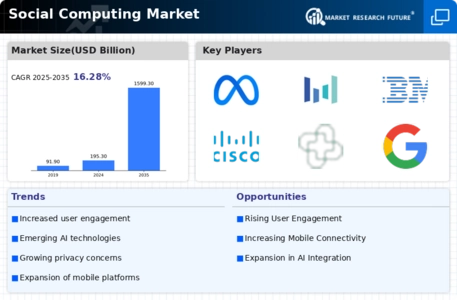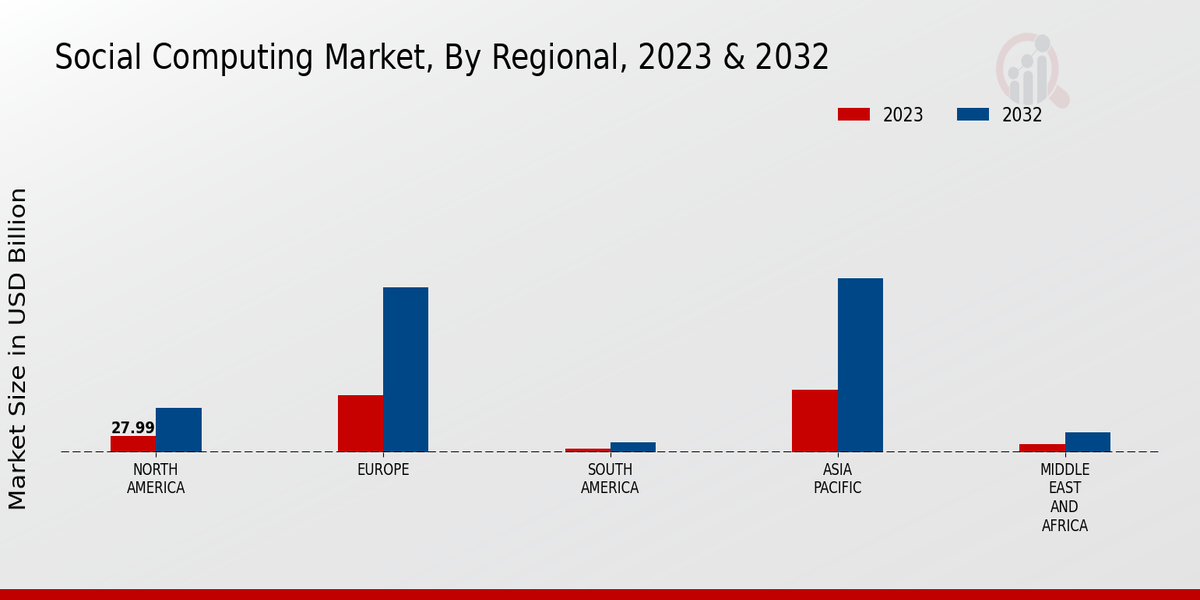Market Growth Projections
The Global Social Computing Market Industry is projected to experience remarkable growth, with estimates indicating a market value of 195.3 USD Billion in 2024 and a staggering 1599.3 USD Billion by 2035. This growth trajectory suggests a compound annual growth rate (CAGR) of 21.06 percent from 2025 to 2035. Such projections reflect the increasing importance of social computing in everyday life, as more individuals engage with various platforms for communication, entertainment, and information sharing. The anticipated expansion underscores the evolving nature of social interactions in a digital age, highlighting the market's potential for innovation and development.
Rising Internet Penetration
The Global Social Computing Market Industry experiences substantial growth due to the increasing internet penetration rates worldwide. As of 2024, approximately 5.3 billion people are expected to use the internet, representing about 67 percent of the global population. This connectivity fosters social interactions and the sharing of information across diverse platforms. The proliferation of smartphones and affordable data plans further enhances accessibility, allowing users from various demographics to engage in social computing. This trend is likely to contribute significantly to the projected market value of 195.3 USD Billion in 2024, setting the stage for continued expansion.
Increased Focus on Data Privacy
The Global Social Computing Market Industry is witnessing a heightened focus on data privacy and security, influencing user trust and platform engagement. As concerns over data breaches and misuse of personal information escalate, social computing platforms are compelled to adopt stringent privacy measures. This shift not only protects users but also enhances the credibility of platforms, fostering a more secure environment for social interactions. Companies that prioritize data privacy are likely to attract a larger user base, contributing to the overall growth of the market. This trend is essential as the industry navigates the complexities of user trust in a digital landscape.
Emergence of Niche Social Platforms
The emergence of niche social platforms within the Global Social Computing Market Industry is reshaping the landscape of online interactions. These platforms cater to specific interests or demographics, providing tailored experiences that resonate with particular user groups. As a result, users are increasingly drawn to platforms that align with their passions, leading to heightened engagement and community building. This trend reflects a broader shift towards personalization in social computing, potentially driving market growth as these niche platforms gain traction. The diversification of social media options indicates a dynamic evolution in how individuals connect and share within their communities.
Integration of Artificial Intelligence
The integration of artificial intelligence technologies within the Global Social Computing Market Industry is transforming user experiences and engagement. AI-driven algorithms enhance content personalization, enabling platforms to deliver tailored recommendations that resonate with individual preferences. This technological advancement not only improves user satisfaction but also increases the time spent on social platforms. As AI continues to evolve, it is likely to play a pivotal role in shaping the future of social computing, potentially driving market growth at a CAGR of 21.06 percent from 2025 to 2035. This integration underscores the importance of technology in enhancing social interactions.
Growing Demand for User-Generated Content
The Global Social Computing Market Industry is significantly influenced by the escalating demand for user-generated content. As individuals increasingly seek authentic and relatable experiences, platforms that facilitate content creation and sharing are thriving. This trend is evident in the rise of social media platforms, blogs, and video-sharing sites, where users actively contribute content. The market's growth trajectory suggests that by 2035, the industry could reach a staggering 1599.3 USD Billion, driven by the continuous engagement of users who prefer peer-generated content over traditional media. This shift indicates a fundamental change in how information is consumed and shared globally.

























